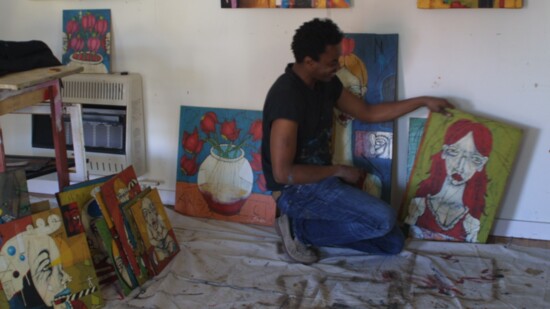Becoming an artist was something Michael Banks had to do for himself rather than for an audience. The Guntersville, Alabama native grew up with a single mother who constantly reminded him of his intrinsic worth and talent – and her fierce love helped Michael look beyond any boundaries on his creative journey.
Though the family lived in housing projects and did not have the means to purchase traditional art supplies such as paint brushes, canvases, or acrylics, young Michael was not deterred. Looking back now, he laughs, thinking about how he would take his mother’s mascara and lipstick, transitioning the cosmetics into makeshift art media. As for a canvas, anything could and would suffice, from a paper bag to the very four walls of their modest home. “I never grew up with a paintbrush – all the things that other people had, I didn’t have access to,” he says. “When I saw the walls on the housing projects, they were all white, and I viewed them as my canvas.”
Understanding her son was creating art the best way he knew how, Ann Banks was the furthest thing from frustrated at her son; rather, she continued to encourage his blossoming talent. Michael is swift to point out that his mother was his first and truest mentor, however, another mentor surfaced during his middle school years: a teacher who hailed from Europe. “She was an artist, we connected, and she showed me what was going on in the art world and how I was already doing it,” Michael explains. “She allowed my mind to explore these new avenues of Picasso and Warhol, people like that.”
Inspired by his new knowledge that art could take you places, Michael made a declaration of his destiny soon afterward to his family: He would grow up and become an artist. Ann gave the plan her blessing, saying that he could “be whatever he wanted, but he would need to finish high school first.”
Sadly, Michael’s mother passed away during his teenage years, and grief took a stronghold. The young man put his art aside for a while, having lost his first muse. Fortunately, what he’d learned from his mother – to stave off negativity and keep going despite challenges – eventually won out. Michael’s first paid job was a position he’d landed with the support of Jenny Wallace, his guidance counselor – working at Lake Screen Printing in Guntersville. “Art was my destiny, and I didn’t need higher education to do it,” he says. “Being a self-taught artist was my destiny.”
Michael’s path eventually took him to Birmingham, where he displayed some of his original pieces in the well-known Magic City Art Connection, and a new audience would admire and purchase his art. Just last year, he returned to the festival for the first time in a long time – family and the demands of life had kept him busy – and was delighted to find that his fans remembered him and local galleries were displaying his work.
“My work was already displayed in Canary Gallery,” he beams. “So I met with Libby (Pantazis, Canary Gallery’s owner) and we decided on a solo show this July.”
Reflecting on everything that has brought him to this moment, Michael says his work is a testament to himself – he believes strongly in creating art that is distinctive to his perspective, and he is willing to still be surprised and transformed by life. “In a lot of ways, I’m still a student,” he points out. “And the best way I can put it is this: I want my art to be different and to be mine.”
Of course, he’s had his artistic influences. But it’s the emotion, not the craft, that this self-taught creative takes to heart.
“I would stare at Norman Rockwell’s Saturday Evening Post paintings on our calendar,” he says, chuckling. “I loved them – I love realism and wanted to know about him. I also had a book about Robert Rauschenberg and Jasper Johns. Reading about these New York artists and their passion for creating full-time . . . it wasn’t their art I wanted to emulate, but their passion.”
Michael Banks’ art will be exhibited by Canary Gallery this month with an opening reception slated for Thursday, July 18 from 5-7 p.m.
“When I saw the walls on the housing projects, they were all white, and I viewed them as my canvas.”
